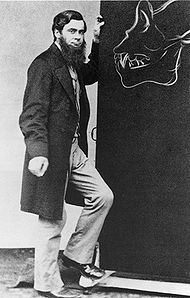
Like many textbook stories, the story of evolutionary discovery my classmates and I were presented with was clean, neat and hopelessly flawed. Darwin was not the first naturalist to propose that evolution was a reality; many of his colleagues thought that natural selection was too weak of a force to affect evolution, and for several decades following the 1859 publication of On the Origin of Species, many naturalists preferred alternative evolutionary mechanisms such as large-scale mutations and internal forces driving organisms onward and upward. Darwin was not even the first naturalist to come up with the idea of natural selection. Many naturalists had previously considered it and thought that it could at best preserve life as is and at worst destroy species. (As for Alfred Russel Wallace and the role he played in the development of evolutionary ideas, my classmates and I didn’t have a clue that he existed.)
The significance of Darwin’s work was in his demonstration of how natural selection could modify life and create a branching pattern of diversity over vast expanses of time. He had worked long and hard to collect all the necessary data to support his case. There was no “Newton’s Apple” type moment—another favorite science myth—in which a Galapagos finch perched on Darwin’s shoulder and whispered the secrets of evolution to the previously clueless naturalist. In Darwin’s time evolution was a frequently discussed issue, and the debate over what natural laws drove the change in species continued long after 1859.
Almost every major figure of the emerging field of evolutionary science has been miscast at one time or another. Richard Owen, one of the first evolutionists, has been traditionally portrayed as a brooding creationist for his opposition to natural selection. St. George Jackson Mivart met a similar fate despite the seriousness with which Darwin took his objections. Charles Lyell, on the other hand, became the white knight of geology who did away with the religiously fundamentalist views of catastrophic change popularized by Georges Cuvier (yet another myth). In order to preserve any semblance of the intellectual March of Progress each character must take up their proper place in the historical drama; they must fall along a simple chain of succession from ignorance to understanding. But among the most pernicious myths are those which seek to honor past scholars for the wrong reasons.
In 1996 a single photograph caused quite a stir at the annual Society of Vertebrate Paleontology meeting in New York City. The picture depicted a small dinosaur in the classic death pose—head thrown back and stiff tail levered straight up—but it was covered in a fuzzy coat of rudimentary feathers. Eventually named Sinosauropteryx, this creature was the first feathered dinosaur to be found since the first specimens of Archaeopteryx were chiseled out of German limestone quarries in the late 19th century. It was a stunning confirmation of what many paleontologists had come to suspect on the basis of anatomy alone—that birds had evolved from dinosaurs, and many characteristic avian traits appeared among dinosaurs first. John Ostrom, Bob Bakker and other paleontologists were not the first to support this idea. The hypothesis had once been among the most prominent explanations for the origin and birds, and many authorities credited the Victorian naturalist Thomas Henry Huxley as being the first to propose it.
Huxley is often included among Darwin’s supporting cast. He was a prominent public voice for evolutionary science while Darwin mostly kept track of the discussions and debates about evolution through correspondence. In fact, Huxley was among the first scientists to propose graded lines of descent for birds, whales and horses, but his determination of these evolutionary transitions required a circuitous process of discovery and realization. Huxley’s ideas about bird origins, especially, were not a perfect anticipation of our current knowledge, but a set of nuanced hypotheses which relied on Huxley’s idiosyncratic conception of evolution.
(More…)


